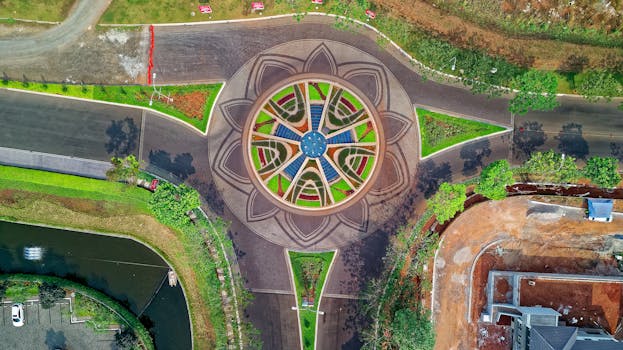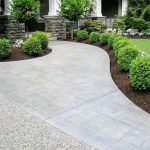Landscape design is both an art and a science, transforming outdoor spaces into functional and aesthetically pleasing environments. Whether you’re designing your own garden or exploring the profession, understanding the principles and processes of landscape design is essential. In this comprehensive guide, we’ll walk through the seven steps of landscape design, explore the principles that guide it, and discuss how to teach yourself this valuable skill.

What is Landscape Design?
Landscape design involves planning and creating outdoor spaces that harmonize with their surroundings while meeting practical needs. A landscape designer’s role includes selecting plants, designing pathways, arranging features like water elements or seating areas, and creating layouts that balance beauty and function. The process requires creativity, knowledge of horticulture, and an understanding of spatial planning.
The Seven Steps to Landscape Design
To create an effective landscape design, follow these seven foundational steps:
1. Analyze Your Site
Begin by understanding your space. Observe sunlight patterns, soil quality, drainage, and any existing features like trees or buildings. Note any challenges, such as steep slopes or shaded areas. A thorough site analysis will guide your design decisions.
2. Determine Your Needs and Goals
What purpose will your landscape serve? Consider factors such as:
- Will it be a family space with a lawn for kids?
- Do you want a low-maintenance garden?
- Is it meant for entertaining, with a patio or firepit?
Define your goals to ensure the design meets your lifestyle and preferences.
3. Create a Base Plan
A base plan is a scaled drawing of your property, showing existing features such as boundaries, structures, and utilities. Use graph paper or digital tools to draw an accurate map. This plan will serve as the foundation for your design.
4. Develop a Concept Plan
Sketch rough ideas for your landscape layout, incorporating desired elements like garden beds, pathways, seating areas, or water features. Experiment with different arrangements to find the most visually appealing and functional layout.
5. Choose Plants and Materials
Select plants based on your climate, soil, and maintenance preferences. Consider color, texture, and seasonal changes to create year-round interest. Choose hardscape materials (e.g., stone, wood, or concrete) that complement the style of your home and garden.
6. Finalize the Design
Refine your concept plan into a detailed design. Specify plant types, materials, dimensions, and placement. Ensure that all elements work together harmoniously and that practical needs, such as irrigation and drainage, are addressed.
7. Implement Your Design
With a finalized plan in hand, it’s time to bring your design to life. Depending on the scale of the project, you may hire contractors for hardscaping or DIY the installation. Follow your plan step-by-step to achieve your vision.
The Three Major Principles of Landscape Design
Three key principles guide effective landscape design, ensuring balance, cohesion, and appeal:
1. Unity
Unity refers to the consistent use of elements to create a cohesive look. Repeating patterns, colors, and materials throughout the landscape establishes harmony. For example, using the same type of stone for pathways and retaining walls ties the design together.
2. Balance
Balance involves arranging elements to create visual stability.
- Symmetrical balance is achieved by mirroring elements on either side of a central axis.
- Asymmetrical balance uses contrasting elements to achieve equilibrium without exact replication.
Balance ensures that the landscape feels well-proportioned and organized.
3. Proportion
Proportion relates to the size of elements in relation to each other and the overall space. For example, a large tree may overwhelm a small yard, while tiny shrubs can get lost in a vast garden. Proper proportion creates a sense of scale and harmony.
Can You Teach Yourself Landscape Design?
Yes, you can teach yourself landscape design with dedication and the right resources. Here’s how to get started:
1. Educate Yourself
Explore books, online courses, and tutorials on landscape design. Learn about topics such as plant selection, soil science, and design principles. Some excellent resources include:
- Books: “Home Outside” by Julie Moir Messervy or “Landscape Design: A Cultural and Architectural History” by Elizabeth Barlow Rogers.
- Websites: Platforms like Houzz or the American Society of Landscape Architects (ASLA).
- Software: Tools like SketchUp or AutoCAD for digital design.
2. Observe and Analyze
Study gardens, parks, and outdoor spaces to understand how they’re designed. Pay attention to plant combinations, hardscape elements, and spatial layouts. Take notes and photographs for inspiration.
3. Start Small
Practice by designing a small section of your yard, such as a flower bed or patio area. Experiment with different layouts and plants to build your skills and confidence.
4. Learn by Doing
Hands-on experience is the best teacher. Work on DIY projects, volunteer at community gardens, or help friends with their landscaping. Each project will enhance your knowledge and abilities.
What Does a Landscape Designer Do?
A professional landscape designer combines technical knowledge with artistic vision to create outdoor spaces. Their responsibilities include:
- Consultation: Meeting with clients to understand their preferences and needs.
- Design: Creating detailed plans and 3D models of proposed landscapes.
- Plant Selection: Choosing plants suited to the climate, soil, and aesthetics.
- Project Management: Overseeing installation and coordinating with contractors.
Landscape designers also consider environmental factors, such as water conservation and sustainable practices, to create eco-friendly designs.
Conclusion
Landscape design is a dynamic and fulfilling field, whether pursued professionally or as a personal passion. By understanding the seven steps of the design process, mastering the principles of unity, balance, and proportion, and embracing a hands-on approach, you can create stunning outdoor spaces that reflect your vision. With resources readily available, teaching yourself landscape design is not only possible but also deeply rewarding. So grab a notebook, sketch your ideas, and start transforming your outdoor space today!



